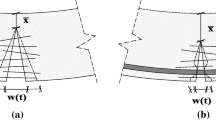We propose a computational model for the evaluation of the service life of fiber-reinforced concrete structural elements subjected to long-term tension. The model is based on the first law of thermodynamics and a proposed idealized tensile stress-strain diagram of fibrous concrete. This model is used for the evaluation of the service life of a fiber-reinforced concrete plate containing a circular hole under the conditions of long-term bilateral tension.





Similar content being viewed by others
References
О. E. Andreikiv, V. R. Skal’s’kyi, I. Y. Dolins’ka, and O. K. Raiter, “Methods for the evaluation of strength and durability of fiberreinforced concretes (a survey),” Fiz.-Khim. Mech. Mater., 54, No. 3, 19–36 (2018); English translation: Mater. Sci., 54, No. 3, 309–325 (2018).
S. F. Neutov, M. M. Sydorchuk, and M. H. Sur’yaninov, “Investigation of creep of steel-fiber concretes,” Nauk. Notatky, Issue No. 60, 181–186 (2017).
O. E. Andreikiv and N. B. Sas, “Fracture mechanics of metallic plates under the conditions of high-temperature creep,” Fiz.-Khim. Mech. Mater., 42, No. 2, 62–68 (2006); English translation: Mater. Sci., 42, No. 2, 210–219 (2006).
O. E. Andreikiv and N. B. Sas, “Strength of thin-walled structural elements with cracks under the conditions of creep,” Fiz.-Khim. Mech. Mater., 43, No. 2, 33–39 (2007); English translation: Mater. Sci., 43, No. 2, 174–182 (2007).
E. K. Opbul and S. S. Sedip, “Strength and crack resistance of bent elements made of disperse-reinforced concrete with highstrength reinforcement without preliminary stresses,” Vestn. Tuvinsk. Gos. Univ., Ser. Tekh. Fiz.-Mat. Nauki, No. 3, 43–54 (2014).
V. V. Bozhydarnyk and H. T. Sulym, Elements of the Theory of Elasticity [in Ukrainian], Svit, Lviv (1994).
V. V. Panasyuk, O. E. Andreikiv, and V. Z. Parton, Foundations of Fracture Mechanics [in Russian], Naukova Dumka, Kiev (1988).
L. R. Mailyan and E. S. Aivazyan, “Numerical analysis of the strength and strain characteristics and stress–strain diagrams of fibrous concretes with aggregated distribution of fibers,” Inzh. Vestn. Dona, Issue 3 (46), 1–10 (2013).
Author information
Authors and Affiliations
Corresponding author
Additional information
Translated from Fizyko-Khimichna Mekhanika Materialiv, Vol. 56, No. 3, pp. 7–14, May–June, 2020.
Rights and permissions
About this article
Cite this article
Andreikiv, О.E., Dolinska, I.Y. & Raiter, O.К. Computational Model for the Evaluation of the Service Life Of Fiber-Reinforced Concrete Structures Under Long-Term Static Loading. Mater Sci 56, 291–300 (2020). https://doi.org/10.1007/s11003-020-00429-7
Received:
Published:
Issue Date:
DOI: https://doi.org/10.1007/s11003-020-00429-7




